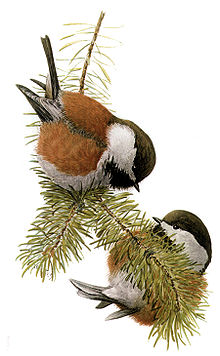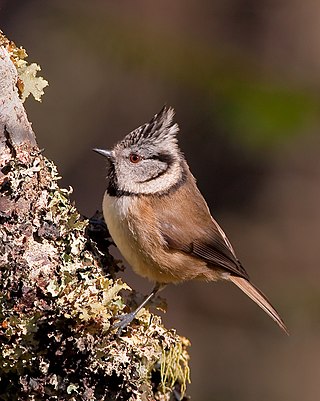
The tits, chickadees, and titmice constitute the Paridae, a large family of small passerine birds which occur mainly in the Northern Hemisphere and Africa. Most were formerly classified in the genus Parus.

The marsh tit is a Eurasian passerine bird in the tit family Paridae and genus Poecile, closely related to the willow tit, Père David's and Songar tits. It is a small bird, around 12 cm (4.7 in) long and weighing 12 g (0.42 oz), with a black crown and nape, pale cheeks, brown back and greyish-brown wings and tail. Between 8 and 11 subspecies are recognised. Its close resemblance to the willow tit can cause identification problems, especially in the United Kingdom where the local subspecies of the two are very similar: they were not recognised as separate species until 1897.
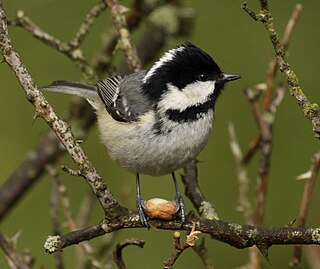
The coal tit or cole tit,, is a small passerine bird in the tit family, Paridae. It is a widespread and common resident breeder in forests throughout the temperate to subtropical Palearctic, including North Africa. The black-crested tit is now usually included in this species.
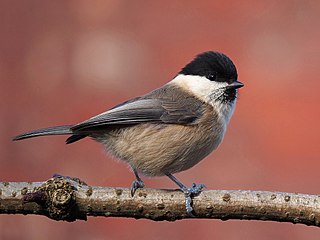
The willow tit is a passerine bird in the tit family, Paridae. It is a widespread and common resident breeder throughout temperate and subarctic Europe and across the Palearctic. The plumage is grey-brown and off-white with a black cap and bib. It is more of a conifer specialist than the closely related marsh tit, which explains it breeding much further north. It is resident, and most birds do not migrate.

The black-capped chickadee is a small, nonmigratory, North American passerine bird that lives in deciduous and mixed forests. It is a member of the Paridae family, also known as tits. It has a distinct black cap on its head, a black bib underneath, and white cheeks. It has a white belly, buff sides, and grey wings, back, and tail. The bird is well known for its vocalizations, including its fee-bee call and its chick-a-dee-dee-dee call, from which it derives its name.

The Carolina chickadee is a small passerine bird in the tit family Paridae.
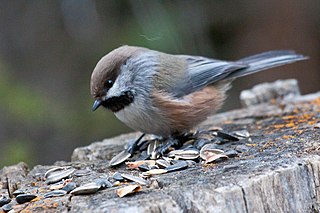
The boreal chickadee is a small passerine songbird in the tit family Paridae. It is found in the boreal forests of Alaska, Canada and the northern United States and remains within this range all year. This bird is known for its high pitched trill patterns used in communication with other birds and food storage habits in preparation for winter months.

The grey-headed chickadee or Siberian tit, formerly Parus cinctus, is a passerine bird in the tit family Paridae. It is a widespread resident breeder throughout subarctic Scandinavia and the northern Palearctic, and also into North America in Alaska and the far northwest of Canada. It is a conifer specialist. It is resident, and most birds do not migrate. Curiously, the bird has no grey on its head, which is black, white, and brown.

The mountain chickadee is a small songbird, a passerine bird in the tit family Paridae.

The Mexican chickadee is a small songbird, a passerine bird in the tit family Paridae. It is still often placed in the genus Parus with most other tits, but mtDNA cytochrome b sequence data and morphology suggest that separating Poecile more adequately expresses these birds' relationships. The American Ornithologists' Union had been treating Poecile as distinct genus for some time already.

The sombre tit is a member of the tit family found in southeast Europe and southwest Asia. Sombre tits occur in low density in thin woodlands at the elevation range between 1000 and 1600 metres above sea level. Similar to the other tit species, the sombre tit is a cavity-nesting species, which makes the nests in the holes in juniper, willow, poplar, and other relevant tree species. In some cases they nest in iron pipes, and in artificial nest-boxes. The clutch usually consists on 4 to 9 eggs, having two clutches per year. The species appear to be resident in the country with slight local movements. They breed on mountain slopes and in open deciduous forest; lower down on in trees and bushes in rocky terrain, as well as in fruit orchards. The breeding season lasts from early April till end of July - beginning of August. The food mainly consists on insects.

The rufous-naped tit, also known as the black-breasted tit or dark-grey tit, is an Asian songbird species in the tit and chickadee family (Paridae). It was sometimes considered conspecific with the rufous-vented tit, and was formerly placed in the genus Parus.
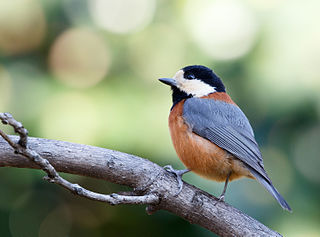
The varied tit is a perching bird from the tit family, Paridae. It occurs in the eastern Palearctic in Japan, Korea, and locally in northeastern China and extreme southeastern Russia.

The rufous-vented tit is an Asian songbird species in the tit and chickadee family (Paridae). Some of its subspecies were formerly assigned to its western relative the rufous-naped tit, or these two were considered entirely conspecific.

The white-browed tit is a species of bird in the tit family Paridae. It is endemic to the mountain forests of central China and Tibet.

Poecile is a genus of birds in the tit family Paridae. It contains 15 species, which are scattered across North America, Europe and Asia; the North American species are the chickadees. In the past, most authorities retained Poecile as a subgenus within the genus Parus, but treatment as a distinct genus, initiated by the American Ornithologists Union, is now widely accepted. This is supported by mtDNA cytochrome b sequence analysis.

The white-shouldered black tit, also known as the pale-eyed black tit, is a passerine bird in the tit family. It breeds in a belt across Africa from Senegal in the west to Kenya and Ethiopia in the east. It is sometimes considered conspecific with the more southerly white-winged black tit Melaniparus leucomelas and, like that species, it is mainly black with a white wing patch, but differs in that it has a pale eye.

The Caspian tit is a passerine bird in the tit family. It breeds in the deciduous mountain forests of northern Iran, just extending into Azerbaijan.

The chickadees are a group of North American birds in the family Paridae included in the genus Poecile. Species found in North America are referred to as chickadees; species found elsewhere in the world are called tits. They are small-sized birds overall, usually having the crown of the head and throat patch distinctly darker than the body. They are at least 6 to 14 centimeters in size.

Chester Barlow was an American cashier and amateur ornithologist who worked in California. He served as the secretary of the Cooper Ornithological Club and he encouraged others to publish in its bulletin on aspects of breeding of the local birds. He also served as the editor for the journals Oologist, The Nidiologist and The Condor.
